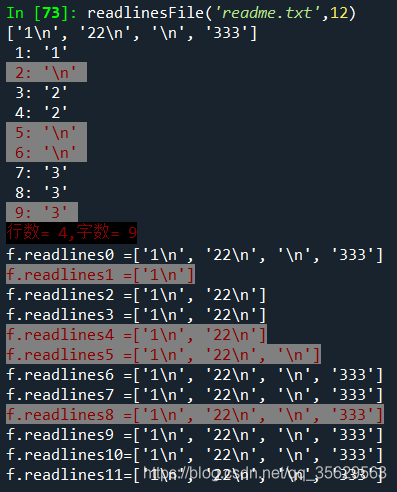python readlines函数 关于python中readlines函数的参数hint的相关知识总结
飞由于度 人气:0readlines的帮助信息
>>> fr=open('readme.txt')
>>> help(fr.readlines)
Help on built-in function readlines:
readlines(hint=-1, /) method of _io.TextIOWrapper instance
Return a list of lines from the stream.
hint can be specified to control the number of lines read: no more
lines will be read if the total size (in bytes/characters) of all
lines so far exceeds hint.
Google翻译
_io.TextIOWrapper 实例的 readlines(hint=-1, /) 方法
从流中返回行列表。
可以指定 hint 来控制读取的行数:如果到目前为止所有行的总大小(以字节/字符为单位)超过hint,则不会读取更多行。
readme.txt中的内容

>>> f=open('readme.txt')
>>> f.readlines()
['1\n', '22\n', '\n', '333']
为了进一步搞清楚hint,我写了一个函数来演示
readlines函数代码
def readlinesFile(filename,nbyte):
'''
探索f.readlines(i)中i的作用,典型的调用形式:
readlinesFile('readme.txt',12)
'''
for i in range(nbyte):
f=open(filename)
ss=f.readlines(i)
if i==0:#如果hint=0,先把每一个元素输出
textline=len(ss)#文件的总行数
ntotalbyte=0#文件的总字数
nwritebyte=0#已经写了的字节数
for j in range(textline):
#nwritebyte=ntotalbyte#已经写了的字节数
ntotalbyte=ntotalbyte+len(ss[j])
rowbyte=0#已经写了的新行的字节数,用来记一行已经输出的字节个数
while nwritebyte<ntotalbyte:#当已写字节<总字节数
print(f'{nwritebyte+1}:',repr(ss[j][rowbyte])) #repr是为了输出换行符
nwritebyte=nwritebyte+1
rowbyte=rowbyte+1
print(f'行数={textline},字数={ntotalbyte}')
print(f'f.readlines{i}={ss}')
f.close()
输出
>>> readlinesFile('readme.txt',12)
1: '1'
2: '\n'
3: '2'
4: '2'
5: '\n'
6: '\n'
7: '3'
8: '3'
9: '3'
行数=4,字数=9
f.readlines0=['1\n', '22\n', '\n', '333']
f.readlines1=['1\n']
f.readlines2=['1\n', '22\n']
f.readlines3=['1\n', '22\n']
f.readlines4=['1\n', '22\n']
f.readlines5=['1\n', '22\n', '\n']
f.readlines6=['1\n', '22\n', '\n', '333']
f.readlines7=['1\n', '22\n', '\n', '333']
f.readlines8=['1\n', '22\n', '\n', '333']
f.readlines9=['1\n', '22\n', '\n', '333']
f.readlines10=['1\n', '22\n', '\n', '333']
f.readlines11=['1\n', '22\n', '\n', '333']
总结:
1.hint 是要输出显示的字节数
2.hint 默认等于-1,就是以列表的形式读出所有内容
3.hint = 0时,效果等同于-1
4.hint 所指的字节数正好是换行符的话,则实际输出是 hint+1
更花哨的readlinesFile
def readlinesFile(filename,nbyte):
'''
探索f.readlines(i)中i是指什么,典型的调用形式:
readlinesFile('readme.txt',12)
'''
specialByte=[]#存储特殊的字节数用
for i in range(nbyte):
with open(filename) as f:#使用with语句就可以不使用f.close()了
ss=f.readlines(i)
if(i==0):#如果hint=0,先把每一个元素输出
print(ss)
textline=len(ss)#文件的总行数
ntotalbyte=0#文件的总字数
nwritebyte=0#已经写了的字节数
for j in range(textline):
#nwritebyte=ntotalbyte#已经写了的字节数
ntotalbyte=ntotalbyte+len(ss[j])
rowbyte=0#已经写了的新行的字节数,用来记一行已经输出的字节个数
while nwritebyte<ntotalbyte:#当已写字节<总字节数
if(nwritebyte is ntotalbyte-1):
specialByte.append(nwritebyte)
print(f'\033[0;31;47m{nwritebyte+1:2d}:',repr(ss[j][rowbyte]),'\033[0m')#\033[0m是字体和背景颜色设置,注意可能需要其他库的支持
else:
print(f'{nwritebyte+1:2d}:',repr(ss[j][rowbyte]))
nwritebyte=nwritebyte+1
rowbyte=rowbyte+1
print(f'\033[0;31;40m行数={textline:2d},字数={ntotalbyte:2d}\033[0m')
if i in specialByte:
print(f'\033[0;31;47mf.readlines{i:<2d}={ss}\033[0m') #<是左对齐
else:
print(f'f.readlines{i:<2d}={ss}') #<是左对齐
效果

参考文章:https:
加载全部内容